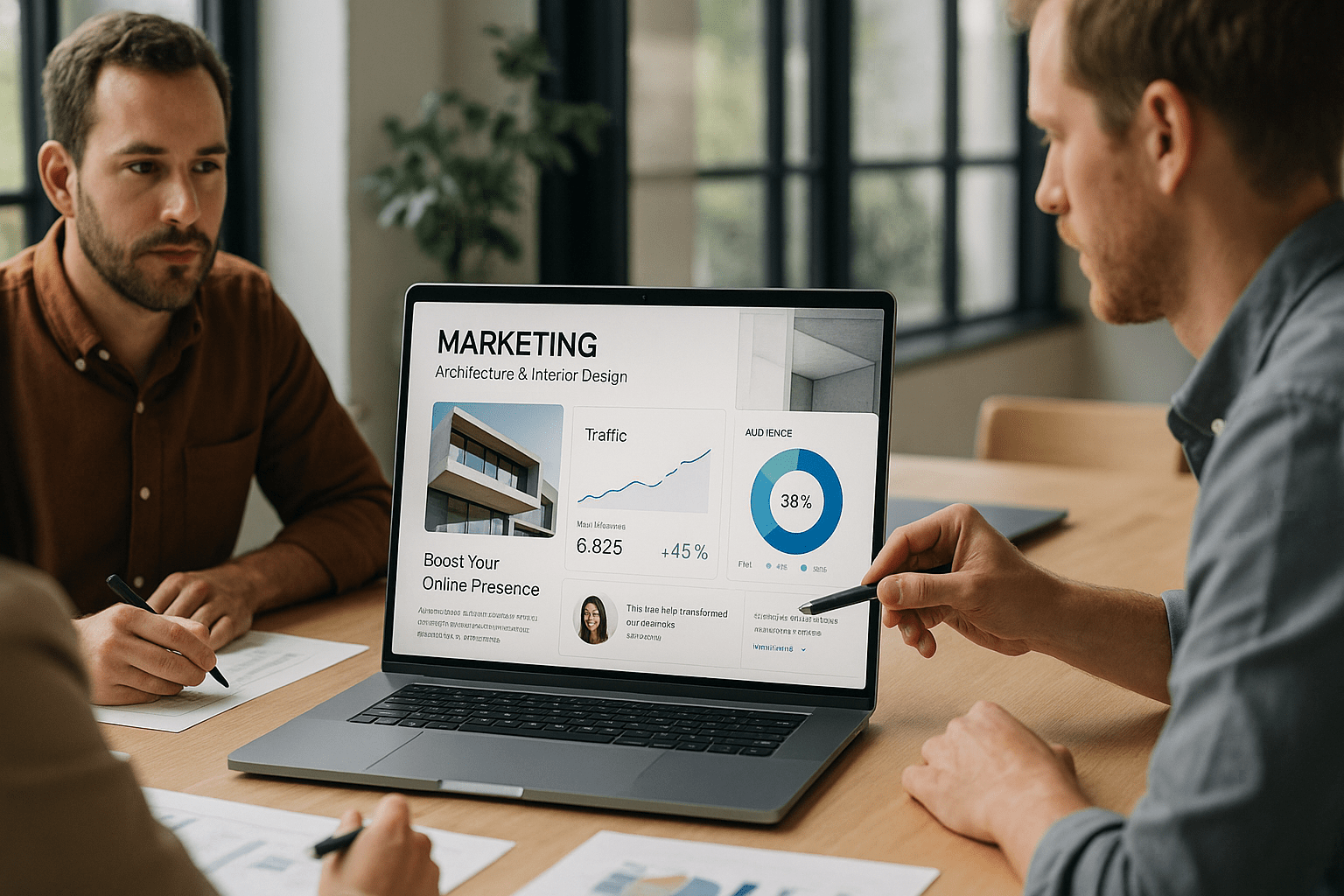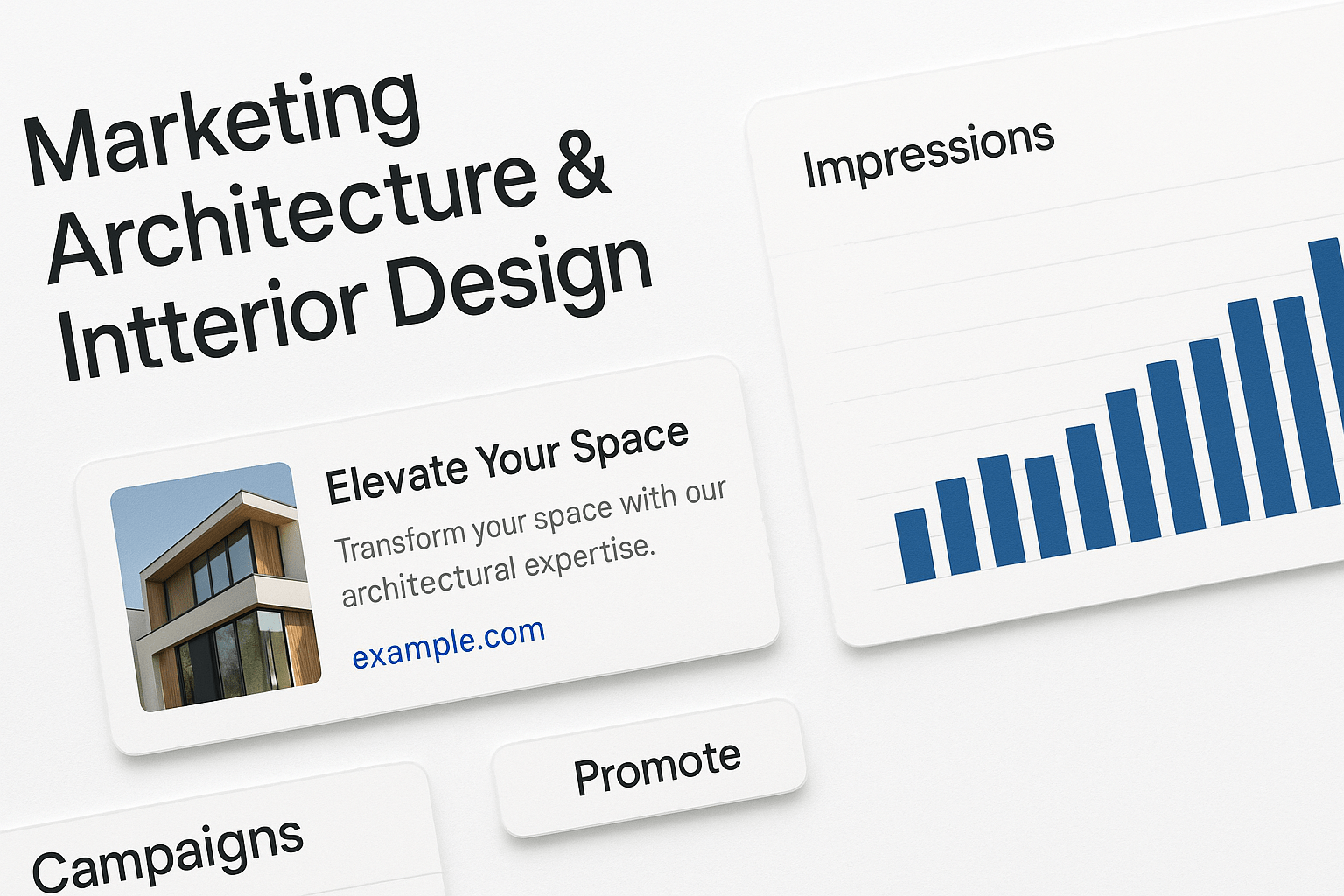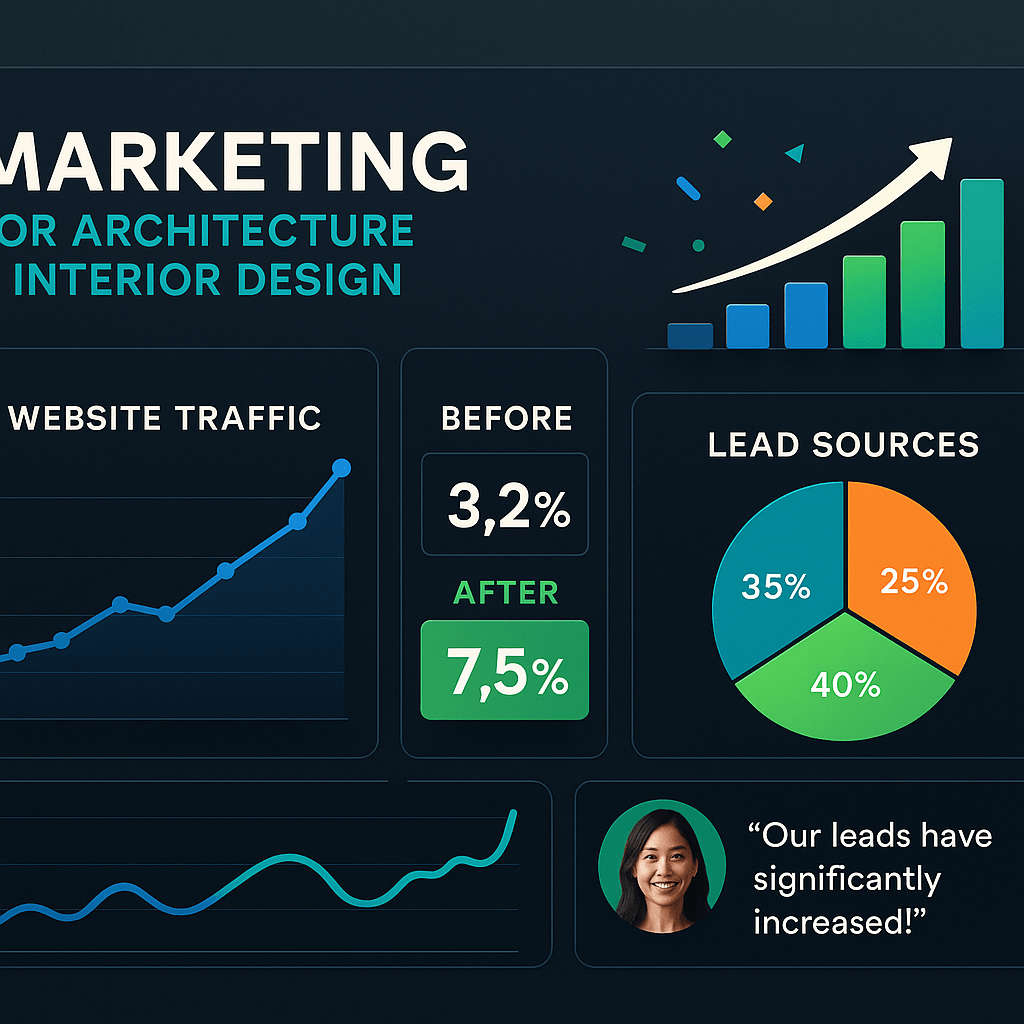Marketing for Architecture & Interior Design: High-Impact Tactics That Win Now
by Design Delulu Editorial · September 24, 2025

In the visually-driven world of architecture and interior design, a stunning portfolio is just the starting point. Today’s most successful firms understand that strategic marketing is essential for attracting high-value clients, building brand authority, and creating a sustainable project pipeline. This guide outlines high-impact marketing tactics that design professionals can implement now to win demand and drive measurable growth.

Why Marketing Matters for Architecture & Interior Design Firms
Marketing for architecture and interior design isn't just about showcasing beautiful projects—it's about building a sustainable pipeline that consistently brings in qualified leads. Smart marketing helps firms position themselves as thought leaders, demonstrate their expertise before prospects even pick up the phone, and create systems that scale beyond individual relationships.
The most successful firms understand that marketing is an investment in long-term growth, not just an expense. When done right, marketing creates compound returns that build momentum over time, establishing your firm as the go-to choice in your market.
Key Benefits of Strategic Marketing for Design Professionals
Editorial Calendar Built on Audience Research
A well-planned editorial calendar ensures consistent, relevant content that speaks directly to your target audience's needs and pain points. By conducting thorough audience research, you can identify the topics, questions, and challenges that matter most to potential clients at different stages of their journey.
Diversified Channel Mix
Effective marketing leverages multiple channels including blog content, email marketing, and social media. This multi-channel approach ensures you're reaching prospects wherever they spend their time online, while reinforcing your message across different touchpoints.
Campaign Creative with User-Generated Content and Thought Leadership
Combining client testimonials, project showcases, and behind-the-scenes content builds trust, while educational content demonstrates expertise.
Attribution-Ready KPIs Aligned to Pipeline
The best marketing strategies include clear measurement frameworks that tie activities directly to business outcomes. This means tracking not just vanity metrics, but KPIs that actually impact your bottom line.

How the Marketing System Works
1. Discovery & Goals: Foundation Setting
Every successful marketing initiative starts with clarity. This phase involves defining specific outcomes, understanding constraints (budget, timeline, resources), and establishing success metrics that align with business objectives.
Key questions to address:
- What are your primary business goals for the next 12 months?
- Who is your ideal client, and what challenges do they face?
- What sets your firm apart from competitors?
- What marketing efforts have you tried before, and what were the results?
2. Blueprint: Strategy and Architecture Design
With goals established, the next step is designing a comprehensive strategy that includes content architecture, channel selection, and measurement planning. This blueprint serves as your roadmap for all marketing activities.
The blueprint should address:
- Content themes and topics that resonate with your audience
- Optimal publishing frequency for each channel
- Visual brand guidelines for consistent presentation
- Lead nurturing sequences that guide prospects through your sales funnel
3. Build & Launch: Implementation and Deployment
Implementation requires careful attention to quality assurance and tracking setup. This phase involves creating content assets, setting up analytics, and deploying campaigns with proper attribution in place.
Critical elements include:
- Content creation workflows that maintain quality while scaling
- Technical setup for tracking and attribution
- Cross-channel coordination to ensure consistent messaging
- Testing protocols to identify and fix issues before full launch
4. Optimize: Data-Driven Iteration
The most successful marketing programs are built for continuous improvement. Regular data analysis identifies what's working and what isn't, allowing you to double down on successful tactics while adjusting or eliminating underperforming elements.
Optimization activities include:
- Weekly performance reviews to catch issues early
- A/B testing of headlines, images, and calls-to-action
- Quarterly strategy resets based on accumulated learnings
- ROI analysis to guide budget allocation decisions

Essential Deliverables for Architecture & Interior Design Marketing
Editorial Calendar
A strategic content calendar that maps topics to your audience's journey, seasonal trends, and business objectives. This ensures consistent publishing while maintaining relevance and strategic alignment.
Content Briefs & Assets
Detailed briefs guide content creation while maintaining quality and consistency. Assets include blog posts, social media content, email templates, and visual elements that support your brand story.
Campaign Creative
Multi-format creative assets designed for specific campaigns and channels. This includes everything from social media graphics to email headers, landing page elements, and promotional materials.
KPI Dashboard
A centralized dashboard that tracks the metrics that matter most to your business. This should include both leading indicators (website traffic, social engagement) and lagging indicators (qualified leads, closed deals).
Best Practices for Architecture & Interior Design Marketing
Prioritize High-Impact Activities First
Focus your initial efforts on the pages and flows that have the greatest potential to drive results. This typically means optimizing your homepage, services pages, and key conversion paths before expanding to secondary content.
Pair Creative with Measurement
Every piece of content should have a clear purpose and measurable outcome. Whether it's driving website traffic, generating leads, or nurturing existing prospects, ensure you can track the impact of your creative efforts.
Use Templates and Systems for Scalability
Develop reusable templates and standardized processes that maintain quality while enabling faster execution. This includes content templates, approval workflows, and publishing schedules.
Close the Loop with Regular Reviews
Establish consistent review cycles to assess performance and make adjustments. Weekly tactical reviews keep campaigns on track, while quarterly strategic reviews ensure long-term alignment with business goals.
Industry-Specific Marketing Tips for Architecture & Interior Design
Map Search Intent to Buyer Stages
Understanding how potential clients search for design services helps you create content that meets them where they are:
- Awareness Stage: "Modern kitchen design ideas", "Contemporary home architecture trends"
- Consideration Stage: "How to choose an interior designer", "Architecture firm vs. independent architect"
- Decision Stage: "Interior designers near me", "Architecture firms in [city]"
Use Social Proof and Outcomes Early
Architecture and interior design are highly visual, relationship-based industries. Showcasing client testimonials, project outcomes, and behind-the-scenes content early in the marketing funnel builds trust and credibility before prospects are ready to engage directly.
Maintain a Single Source of Truth Dashboard
With multiple marketing channels and touchpoints, it's essential to have one centralized place where you can see the complete picture of your marketing performance. This prevents conflicting data and ensures everyone is working from the same information.
Embrace Rapid Testing and Compound Growth
Instead of launching massive campaigns, focus on smaller experiments that can be quickly tested and optimized. This approach reduces risk while allowing you to compound successful tactics over time.
Measuring Success: KPIs for Architecture & Interior Design Marketing
Primary Revenue-Related Metrics
- Qualified leads generated
- Pipeline value
- Conversion rates
- Customer acquisition cost
- Lifetime value of marketing-acquired clients
Supporting Channel KPIs
- Website traffic growth
- Search rankings
- Social media engagement
- Email performance
- Content engagement
Frequently Asked Questions
How long does marketing for architecture & interior design take?
Most comprehensive marketing engagements run 4–8 weeks depending on scope and feedback loops. However, seeing meaningful results typically requires 3-6 months of consistent implementation, as the architecture and interior design sales cycle tends to be longer than other industries.
What KPIs should architecture & interior design firms track for marketing?
Focus primarily on revenue-related metrics: qualified leads, pipeline value, and sales conversions. Support these with channel-specific KPIs like website traffic, search rankings, and social media engagement. The key is connecting marketing activities directly to business outcomes.
How much should architecture and interior design firms budget for marketing?
Most successful firms invest 7-12% of gross revenue in marketing. This should cover both paid advertising and content creation, with emphasis on building long-term organic visibility through SEO and content marketing.
What content performs best for architecture and interior design marketing?
Visual content showcasing completed projects performs exceptionally well, particularly before/after transformations and detailed case studies. Educational content about design trends, process explanations, and cost guides also drives significant engagement and leads.
Let’s level up your Architecture & Interior Design Marketing
Need marketing that actually moves the needle for architecture & interior design? See our approach, pricing, and timelines—then book a quick call.
Additional Resources and Related Reading
For more comprehensive guidance on marketing for architecture and interior design firms, explore these related resources:
- SEO Services for Architecture & Interior Design
- Social Media Management for Architecture & Interior Design
- Paid Ads Management for Architecture & Interior Design
To explore comprehensive marketing services specifically designed for architecture and interior design firms, visit: our services page.
Ready to discuss your specific marketing needs? Book a consultation call at: Book a Call.
For additional marketing tools and resources, check out: our free AI tools.
You can also view case studies and examples of successful marketing campaigns at: our portfolio.